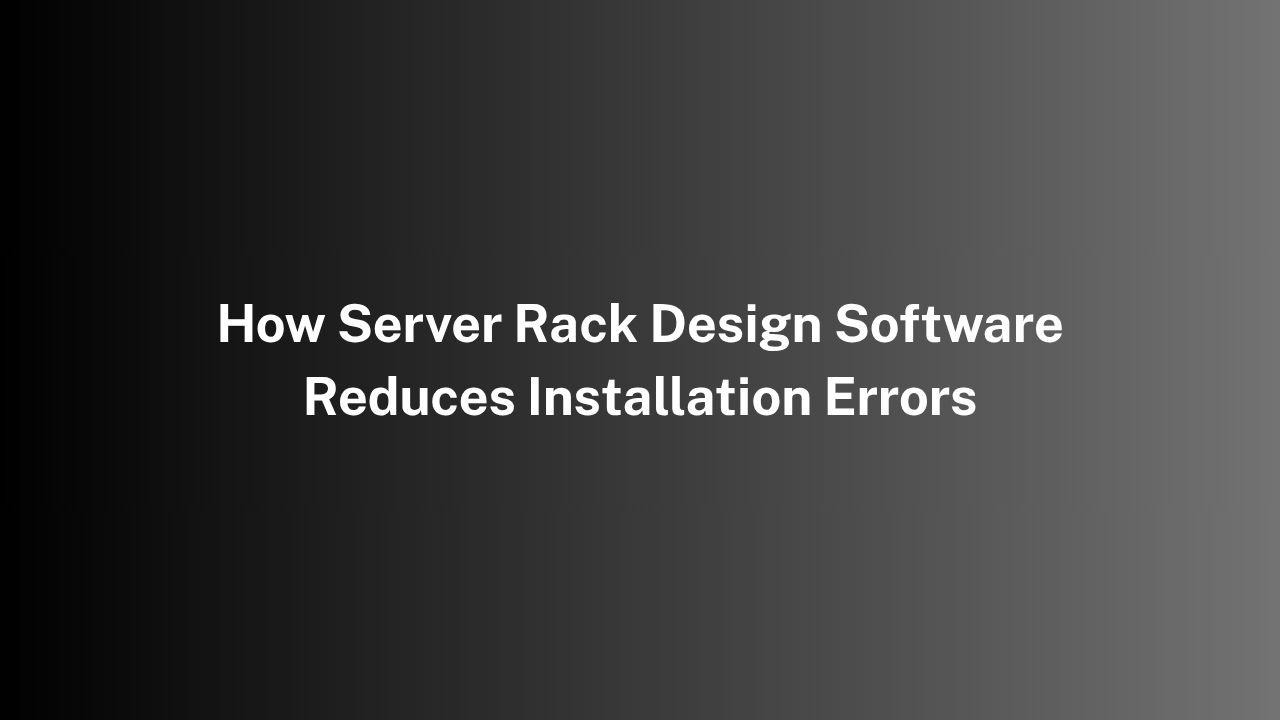In today’s fast-paced digital infrastructure landscape, precision and planning are everything. As businesses scale up data centers, integrate AV and IT systems, or deploy smart building solutions, the backbone of all this innovation lies within the server racks that house critical technology. But as many integrators, IT professionals, and AV designers know, a poorly designed rack can cause more problems than it solves—ranging from overheating to tangled cables, power failure risks, and system downtime.
Enter server rack design software, a category of digital tools that is rapidly changing how professionals approach rack planning and installation. Gone are the days of pen-and-paper layouts, manual calculations, and guessing whether a device will fit. Server rack design software enables precise, real-time planning that not only improves efficiency but significantly reduces installation errors that cost time, money, and credibility.
This blog explores how server rack design software minimizes these risks, improves documentation and workflows, and empowers teams to deliver error-free rack installations—from the smallest AV closet to enterprise-grade data centers.
The Cost of Installation Errors
Before diving into how software helps, it’s important to understand the high stakes involved in server rack installation.
Common Errors in Traditional Rack Installations
-
Incorrect Equipment Placement: Improper height, depth, or clearance allocation can result in units not fitting or blocking airflow.
-
Cable Management Failures: Tangled or insufficient cabling leads to difficulty in maintenance and increased heat.
-
Inadequate Power Distribution: Overloaded power strips and poor circuit planning can cause tripped breakers or equipment failure.
-
Airflow and Cooling Misjudgment: Poorly ventilated racks lead to overheating and degraded performance.
-
Weight Imbalance: Heavy gear installed improperly affects rack stability and safety.
-
Missing or Misused Accessories: Skipped shelves, blanking panels, or PDUs can jeopardize operational integrity.
Each of these issues can result in extra labor, return visits, compromised performance—or even complete system failures.
What Is Server Rack Design Software?
Server rack design software is a specialized digital tool that allows users to plan, visualize, and validate the layout of IT, AV, and networking equipment in a rack enclosure before physical installation begins.
Whether cloud-based or desktop-installed, these tools typically include:
-
Drag-and-drop rack modeling
-
Precise U-spacing and device footprint calculations
-
Power and thermal load estimates
-
Cable path simulation
-
Integration with Bills of Materials (BOM)
-
3D rendering and client-ready visuals
By enabling detailed pre-visualization and validation, server rack design software gives integrators, IT teams, and project managers the ability to spot and correct mistakes before a single piece of hardware is installed.
How Server Rack Design Software Reduces Errors
1. Accurate Space Planning Prevents Fitment Issues
One of the most basic yet overlooked aspects of rack installation is physical space planning. Even a 1U miscalculation can throw off an entire rack design.
Server rack design software eliminates these issues by:
-
Providing real-world dimensions of devices
-
Allowing for real-time drag-and-drop rack layouts
-
Preventing over-allocation of rack units
-
Warning users of overlapping or conflicting placements
For example, XTEN-AV’s design engine automatically ensures that each device has proper front and rear clearance and flags issues with mounting or depth mismatches.
2. Improved Cable Management and Routing
Messy cables are not just an aesthetic problem—they’re an operational risk. Tangled or improperly routed cables make maintenance difficult, restrict airflow, and increase the likelihood of accidental disconnections.
Server rack design software includes tools to:
-
Map precise cable paths
-
Calculate cable lengths
-
Label ports and patch panels
-
Visualize rear rack cabling in 3D
-
Avoid port overloading or mismatches
When cable management is planned in advance using a software platform, installers can follow a clean schematic, reducing human error and saving hours during deployment.
3. Thermal Load Estimation Avoids Overheating
Cooling issues are among the leading causes of rack-related equipment failures. Equipment manufacturers recommend specific thermal guidelines, but these are often overlooked in fast-paced installations.
With server rack design software:
-
Heat loads can be modeled per device
-
Airflow paths can be visualized (front-to-back, side-to-side)
-
Equipment that produces high heat can be positioned to optimize air circulation
-
Cooling requirements can be calculated in advance
This allows IT planners to make design decisions that align with HVAC capacity and airflow planning.
4. Automated Power Load Balancing
Uneven power distribution is another common issue that can cause tripped circuits, downtime, or even fires.
Server rack design software helps prevent this by:
-
Calculating power draw per device
-
Balancing loads across power strips and circuits
-
Identifying redundancy requirements (A/B feed)
-
Flagging potential overload risks
Some platforms also integrate with real-time monitoring tools to adjust future rack designs based on historical energy usage data.
5. Standardization Across Multiple Projects
Large-scale integrators or enterprises rolling out racks across multiple locations benefit from standardization.
Server rack design software enables:
-
Reusable templates for rack layouts
-
Company-specific standards for devices, labeling, and wiring
-
Documented workflows that reduce variance between teams
-
Scalable design libraries that ensure every install follows best practices
This consistency not only improves installation quality but also simplifies troubleshooting and lifecycle management.
6. Simulation of Rack Assembly Process
Several advanced tools allow simulation of the rack build process step by step, helping technicians:
-
Understand install sequence
-
Prevent mounting order conflicts
-
Confirm tool and space requirements
This helps reduce the number of surprises during onsite work, especially when dealing with tight enclosures or limited accessibility.
How It Helps Different Stakeholders
For AV Integrators
-
Validate audio-visual gear compatibility and signal path routing
-
Coordinate rack elements with control system design
-
Reduce return trips due to mounting conflicts
For IT Managers
-
Predict network equipment behavior under load
-
Match UPS capacity with expected power draw
-
Create client-ready visual documentation
For Project Managers
-
Keep design aligned with budgets and milestones
-
Provide installers with detailed drawings and instructions
-
Prevent change orders due to poor planning
For Installers
-
Reduce guesswork during mounting and cabling
-
Eliminate “on-site fixes” that cost time and money
-
Follow visual SOPs that match what they see on-site
Features That Maximize Accuracy
Not all server rack design software is built equally. The most effective platforms offer:
| Feature | Benefit |
|---|---|
| Manufacturer Libraries | Use real specs, not placeholders |
| 3D Visualization | Catch spatial errors before install |
| BOM Integration | Align parts list with physical layout |
| Thermal and Power Calculations | Prevent overload and overheating |
| Cable Pathing | Map exact routes and avoid congestion |
| Labeling Tools | Standardize naming across racks |
| Collaboration Features | Let teams comment and edit in real-time |
When choosing a tool, look for those that offer real-time validation and automated flagging of design issues. This shifts the workflow from reactive to proactive.
Top Software Tools in 2025
Let’s take a quick look at some of the top server rack design software solutions that help reduce errors in 2025.
1. XTEN-AV
XTEN-AV leads the pack with a platform tailored for AV and IT system integrators. It excels at rack layout, signal flow mapping, and proposal generation. Its AI engine ensures that every piece of gear fits, works together, and is justified in the BOM. Real-time updates between rack design, documentation, and diagrams reduce inconsistencies dramatically.
2. Autodesk AutoCAD with Rack Templates
For CAD-savvy users, AutoCAD can offer precision design with rack templates. While more manual, it’s flexible and ideal for engineers familiar with custom specs. However, it lacks error-checking automation.
3. Visio with Add-ons
Still used by many in the industry, Microsoft Visio provides diagramming flexibility. Third-party templates enhance its utility for rack design, but it lacks real-time device libraries and heat/power calculation tools.
4. EPLAN
EPLAN offers powerful electrical and network design integration. Used more in industrial settings, it’s excellent for compliance-heavy installations, though it may be overkill for simple AV racks.
5. NetZoom
NetZoom specializes in data center and network rack design, with access to over 250,000 device specs. It’s ideal for IT-focused professionals who need detailed environmental modeling.
Case Study: Reducing Errors in a University AV Upgrade
A large public university was deploying new AV racks across 12 lecture halls. Prior installations led to overheating and signal delays due to poor cable management and power distribution.
Before Using Server Rack Design Software
-
Inconsistent layouts per room
-
Incorrect rack unit allocations
-
Undersized cooling fans
-
Tripping power circuits
-
Over 20 hours of rework across locations
After Implementing XTEN-AV
-
Standardized racks based on course type
-
Verified thermal and power loads
-
Included labeled cable paths and blanking panels
-
Reduced install time by 30%
-
Zero post-install errors reported
This shift saved the university over $25,000 in change orders and labor within one semester.
Conclusion
As AV and IT systems grow more sophisticated, the infrastructure supporting them—server racks—must be designed with equal intelligence. Manual design processes and guesswork are no longer acceptable, especially when the tools exist to predict, visualize, and eliminate errors before a single bolt is turned.
Server rack design software is the solution to this challenge. From validating clearances and power loads to mapping signal flow and standardizing installations, these tools turn design from a bottleneck into a strategic advantage.
Whether you’re an integrator, designer, or IT project lead, investing in modern server rack design software is the best way to ensure your installations are flawless, future-ready, and free from costly errors.
Read more: https://penposh.com/blogs/437791/Top-5-Server-Rack-Design-Software-Tools-for-AV-and



